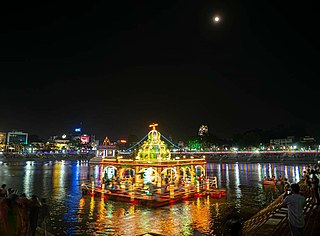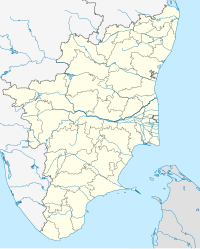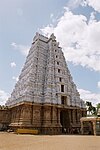
Mylapore, or Thirumayilai, is a neighbourhood in the central part of the city of Chennai, India. It is one of the oldest residential parts of the city. The locality is claimed to be the birthplace of the celebrated Tamil philosopher Valluvar, and the Hindu saint and philosopher, Peyalvar.

The Parthasarathy Temple is a 6th-century Hindu Vaishnavite temple dedicated to Vishnu in Chennai, India. Located in the neighbourhood of Thiruvallikeni, the temple is glorified in the Naalayira Divya Prabandham, the early medieval Tamil literature canon of the Alvar saints from the 6th to 9th centuries CE and is classified as among the 108 Divya Desams dedicated to Vishnu. The name 'Parthasarathy' means the 'charioteer of Arjuna', referring to Krishna's role as a charioteer to Arjuna in the epic Mahabharata.
West Mambalam is a residential and commercial area in Chennai, India. It is known for its shops, bazaars and Hindu temples. It is bounded by Kodambakkam to the north and Saidapet to the south. T. Nagar and Nandanam stretch all along its eastern frontiers while Ashok Nagar lies to its west. The Ayodhya Mandapam is an important landmark.

Vallal Pachaiyappa Mudaliar (1754–1794) or Arcot Pachayyappa Mudaliar was a Madras merchant, philanthropist, and dubash of the 18th century.

George Town is a neighbourhood in Chennai, Tamil Nadu, India. It is near the Fort Saint George, Chennai. It is also known as Muthialpet and Parry's corner. It is an historical area of Chennai city from where its expansion began in the 1640s. It extends from the Bay of Bengal in the east to Park town on the west. The Fort St. George is on the south, to Royapuram in the north. The Fort St. George houses the Tamil Nadu Legislative Assembly and the Secretariat. The High court of Tamil Nadu at Chennai, Dr. Ambedkar Law College, Stanley Medical College and Hospital are located here.

The Nayakas of Kalahasti were a line of rulers of Kalahasti and Vandavasi principalities. Members of the group include Damarla Chennapa Nayaka, after whom the city of Chennai is named. These Nayakas served as vassals of the late Vijayanagara Empire, then held by the Aravidu Dynasty and headquartered at Chandragiri and Vellore.
Buckingham and Carnatic Mills, popularly known as B & C Mills, were textile mills run by Binny and Co. in the city of Chennai, India. The mills were closed down in 1996 and the site is now used as a container freight station and is a popular venue for film shootings.

Chepauk Palace was the official residence of the Nawab of Arcot from 1768 to 1855. It is situated in the neighbourhood of Chepauk in Chennai, India and is constructed in the Indo-Saracenic style of architecture.
Mallikesvarar Temple or Mallikarjunar Temple is a Hindu temple situated in the neighbourhood of George Town in the city of Chennai, India. It is one of the first Hindu temples to be constructed in the British settlement of Madrasapatnam. There is the nearby Chenna kesava perumal Temple. They are twin temples. This is also called Chenna Malleeswarar temple. Chenna pattanam may be named after this deities. The word 'chenni' in Tamil means face, and the temple was regarded as the face of the city.

Ekambareswarar Temple, Chennai is a Hindu temple situated in the neighbourhood of Parry's corner, Chennai, India dedicated to Lord Shiva. It was constructed by Alanganatha Pillai, chief merchant of the Madras factory of the British East India Company.
Suguna Vilasa Sabha is a club founded by Pammal Sambandha Mudaliar, based in the city of Chennai, India. The Suguna Vilasa Sabha club is also called as SVS club. The Suguna Vilasa Sabha club was founded by a band of public spirited men headed by Late Sambanda Mudaliar for promotion of histrionic talent in the year 1891.It is one of the oldest and foremost theatre companies in the city.

The Senate House is the administrative centre of the University of Madras in Chennai, India. It is situated in Wallajah Road, along Marina Beach. Constructed by Robert Chisholm between 1874 and 1879, the Senate building is considered to be one of the best and oldest examples of Indo-Saracenic architecture in India.
Binny and Co is a shipping, textile, banking and insurance firm based in the city of Chennai, India. It is one of the oldest business firms in Chennai city.

Rajaji Hall, previously known as the Banqueting Hall, Madras, is a public hall in the city of Chennai, India used for social functions. The hall was built by John Goldingham to commemorate the British victory over Tipu Sultan in the Fourth Anglo-Mysore War.
Chintadri Pillaiyar Kovil is a Hindu temple in Devaraja Mudali Street in Georgetown, Chennai. The temple is dedicated to Ganesa and was constructed in 1717. The temples is situated close to the Mallikesvarar Temple and was the site of a dispute between the Komati Chetti and Beri Chetti communities in the 18th century.
Chennai, along with Mumbai, Delhi and Kolkata, is one of the few Indian cities that are home to a diverse population of ethno-religious communities. According to the 2011 census Chennai then had a total population of 4,681,087 at a density of 26,902 per square kilometre; the sex ratio was 986 and literacy rate was 90.33%. The most widely spoken languages are Tamil and English. Hinduism is followed by a majority of the populace followed by Islam and Christianity. Sikhism, Jainism, Buddhism and Zoroastrianism are other religions practiced.
Chennai, with historically rich records dating at least from the time of the Pallavas, houses 2,467 heritage buildings within its metropolitan area (CMA), the highest within any metropolitan area limit in India. Most of these buildings are around 200 years old and older. Chennai is home to the second largest collection of heritage buildings in the country, after Kolkata. The official list of heritage buildings was compiled by the Justice E. Padmanabhan committee. The Tamil Nadu Assembly passed the Heritage Commission Act in 2012 to preserve old heritage structures.

China Bazaar Road, officially Netaji Subash Chandra Bose Road, is one of the main thoroughfares of the commercial centre of George Town in Chennai, India. The road connects Rajaji Salai in the east with Wall Tax Road in the west. Passing through thickly populated residential areas of the historical neighbourhood, the road has several streets, lanes, and by lanes joining it housing several commercial establishments of the city.
Chennai is religiously cosmopolitan, with its denizens following various religions, chief among them being Hinduism, Islam, Christianity, Sikhism, Jainism, Buddhism, and Zoroastrianism. Chennai, along with Mumbai, Delhi, Kochi, and Kolkata, is one of the few Indian cities that are home to a diverse population of ethno-religious communities. With the majority of the people in India following Hinduism, Chennai, like other Indian cities, is home to more Hindus than any other religion. Chennai has centres of worship for a multitude of faiths. According to 2001 census, majority of the population are Hindus, Muslims, Christians, Jains, Sikhs, and Buddhists.












